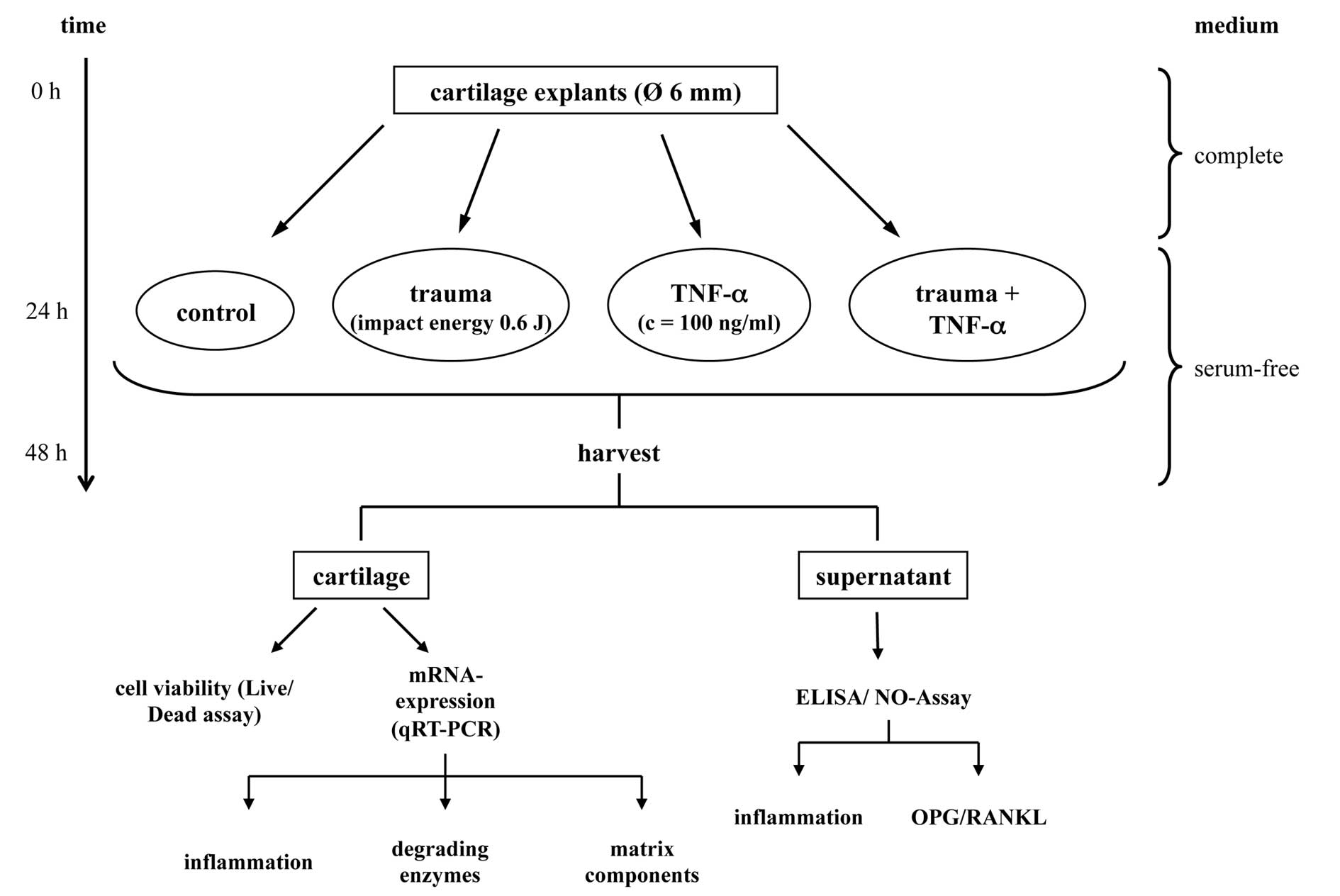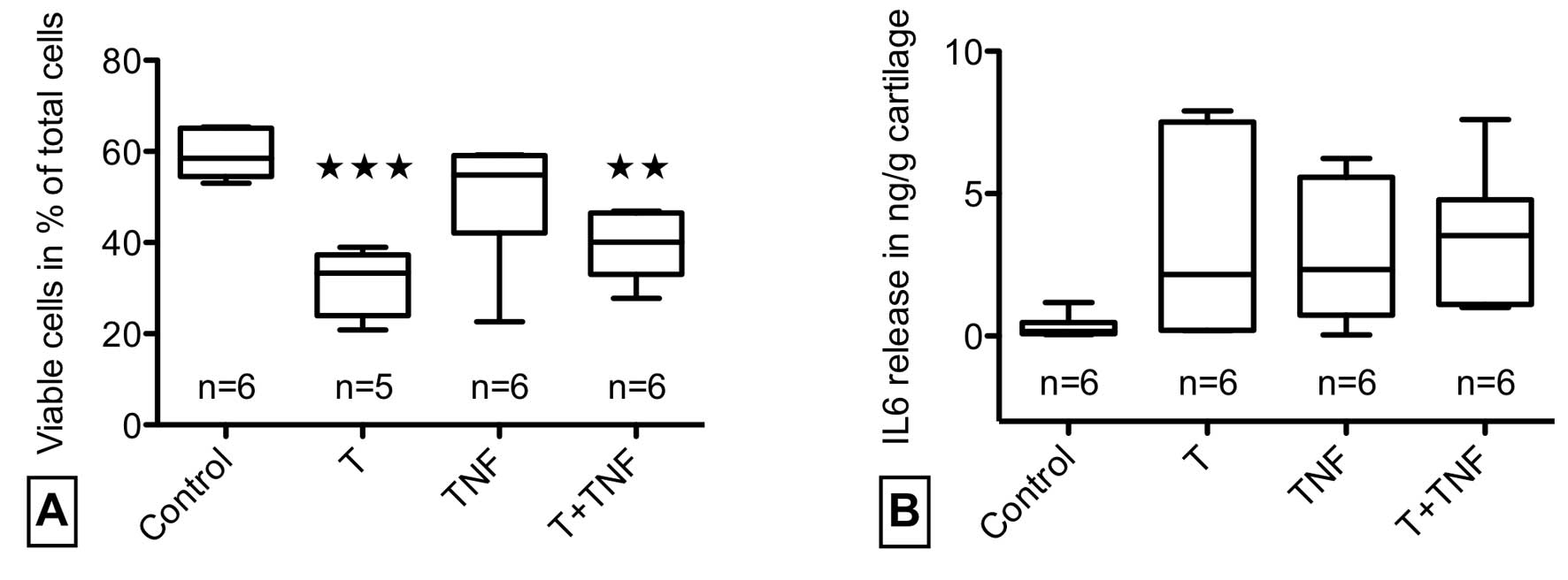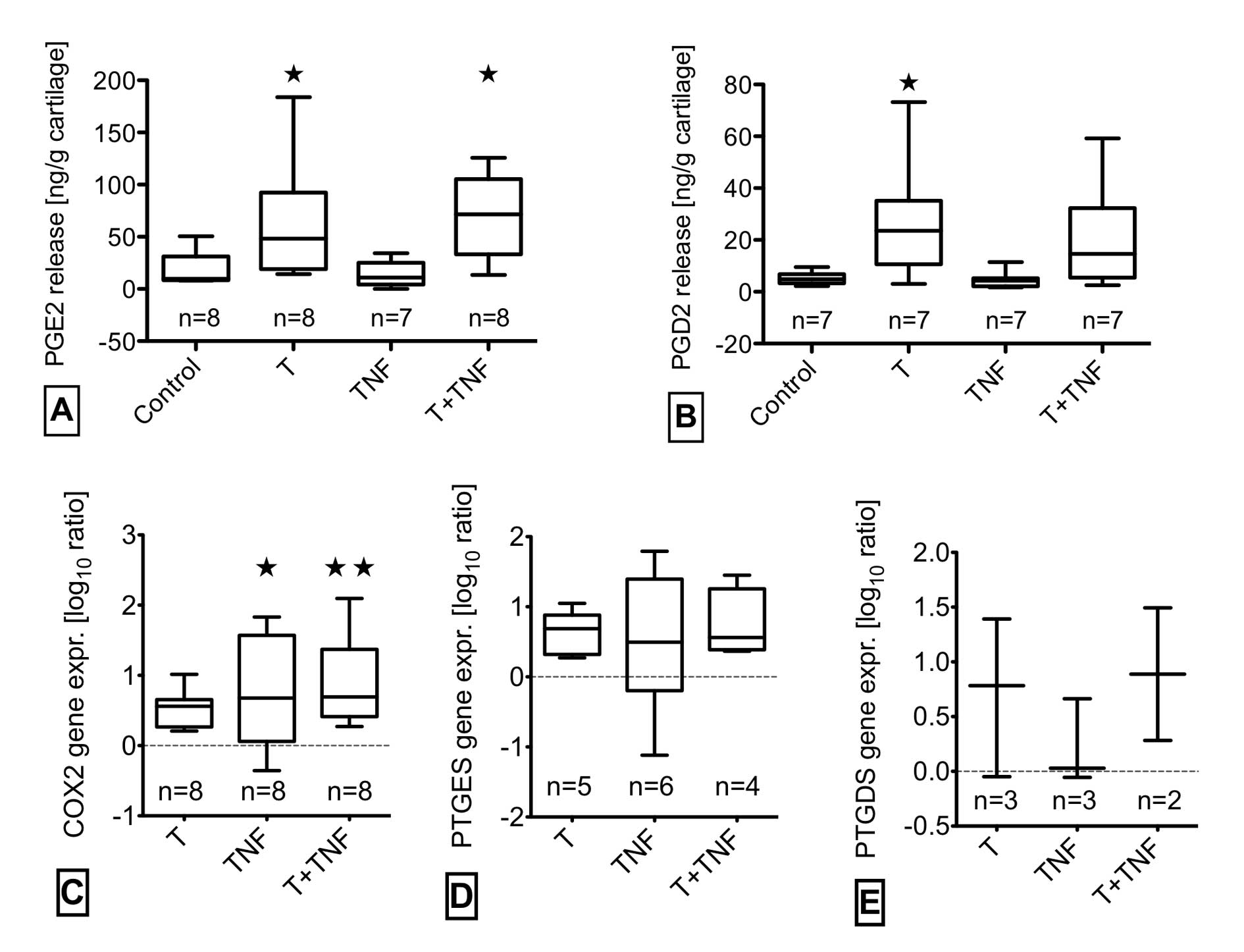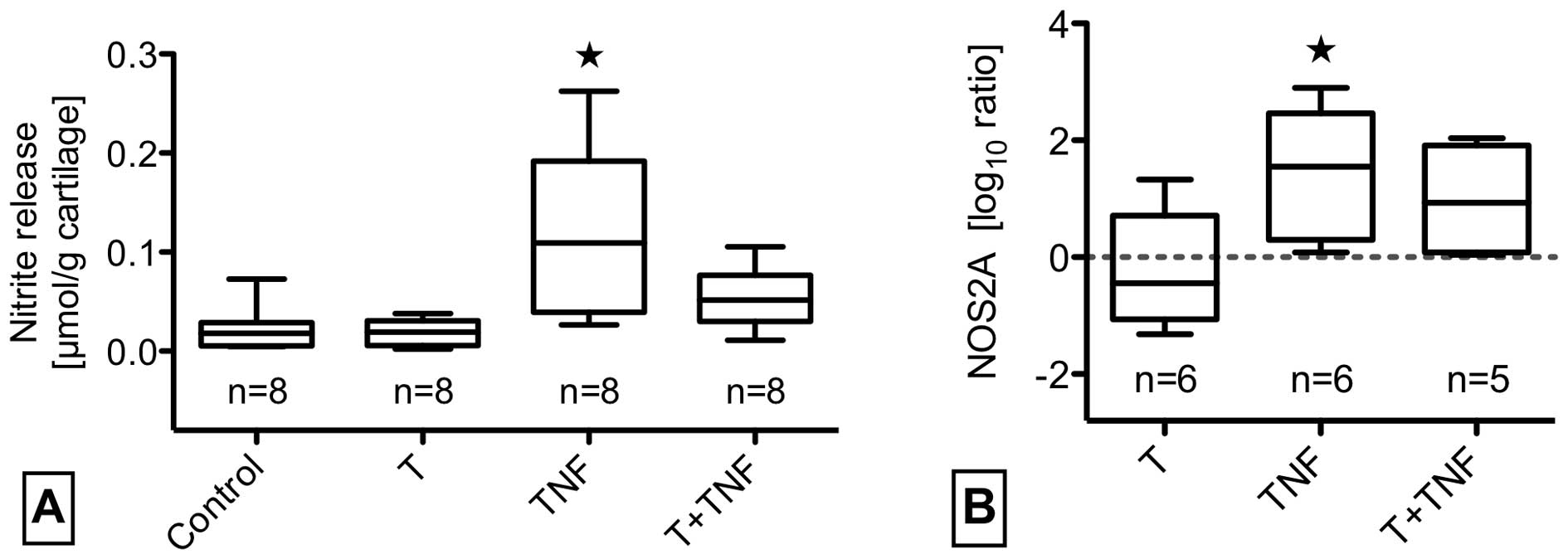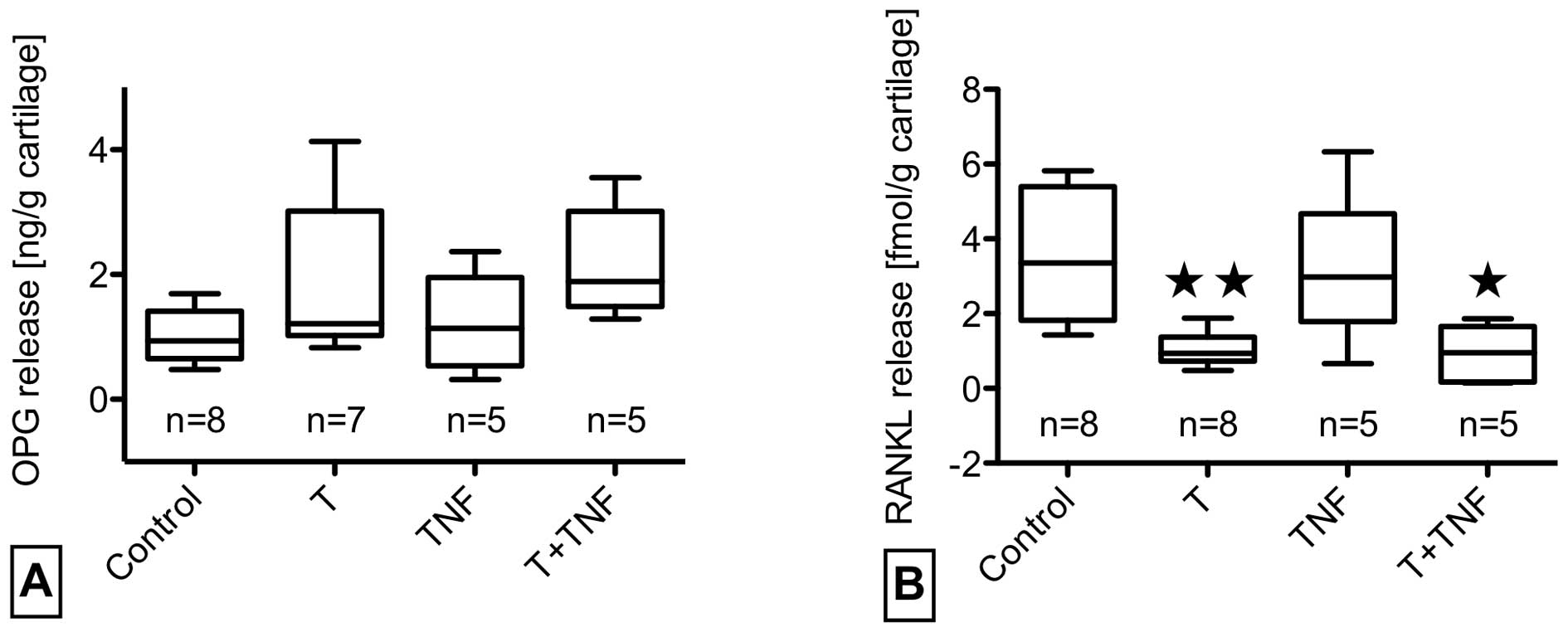Single impact cartilage trauma and TNF-α: Interactive effects do not increase early cell death and indicate the need for bi-/multidirectional therapeutic approaches
- Authors:
- Published online on: August 24, 2012 https://doi.org/10.3892/ijmm.2012.1112
- Pages: 1225-1232
Abstract
Introduction
Traumatic joint damage is a major risk factor for development and/or progression of osteoarthritis (OA) (1). Knee injuries often result from traffic accidents and count for 40% of sports injuries (2–4). The high prevalence of post-traumatic arthritis creates the urgent need for pharmacological interventions, starting in the early phase after injury in which the destructive processes are induced (1,5). Therefore, a detailed knowledge of the underlying pathogenetic mechanisms is crucial but only partly available. The excessive mechanical loading of the articular cartilage results in chondrocyte death that can be attributed to mechanical necrosis (6) and apoptotic processes (7). In addition, mechanical disruption of the extracellular matrix leads to an early loss of glycosaminoglycans (8). Cartilage defects in knee injuries are commonly associated with other pathological conditions of the joint such as anterior cruciate ligament (ACL) ruptures and meniscal injuries (9), leading to an increase of proinflammatory cytokines in the synovial fluid (10). Beside IL-1β and IL-6, which are elevated during the first 3 to 6 days, the level of TNF-α is significantly increased over a period of 3 weeks after ACL ligament injury of the knee with a peak concentration in the first 24 h (11).
Proinflammatory cytokines are known to drive the overall inflammatory process by inducing other cytokines, chemokines and proinflammatory mediators like prostaglandins and NO (12,13). These cytokines enhance cartilage degradation via an activation of catabolic and a decrease of anabolic processes. In particular, degenerative enzymes like matrix metalloproteinases (MMP) 1, 3 and 13 as well as aggrecanases (e.g. ADAMTS 4/5) are induced by TNF-α and/or IL-1β (14–16). In vitro studies with human and bovine cartilage revealed that TNF-α and IL-1α potentiate the effect of cartilage impact, leading to a synergistic loss of proteoglycans and to a reduction of their biosynthesis (17,18). In contrast, IL-1β co-stimulation had no additive effects on cell death in traumatized cartilage during the first 24 h but prostaglandin (PGE2 and PGD2) and NO synthesis pathways were both affected by trauma and/or IL-1β (19). In an apoptosis model of chondrocytes sensitized by actinomycin D, TNF-α but not IL-1β was described to enhance apoptosis indicating differential regulations by these cytokines (20,21). So far, no studies exist on interactions of TNF-α and a single impact cartilage trauma with respect to cell death, prostaglandin or NO metabolism.
Besides well-known effects on cartilage degeneration and inflammation in arthritic diseases like induction of MMPs, aggrecanases, inducible nitric oxide synthase and cyclooxygenase (22,23), TNF-α is also involved in the regulation of bone remodeling by stimulation of receptor activator of nuclear factor (NF-κB) ligand (RANKL) expression in osteoblasts. Binding of RANKL to its receptor RANK on osteoclasts increases bone resorption by promoting their differentiation and activation (24). RANKL and its decoy receptor osteoprotegerin (OPG) are also expressed in human chondrocytes and may play a role in osteoarthritis, where OPG production is increased (25). They may alter the remodeling process of subchondral bone which becomes sclerotic during development of post-traumatic OA.
Overall, TNF-α could have significant influence in the early phase after cartilage trauma. A deeper knowledge of its contribution to induction or progression of post-traumatic OA could be directive for new therapeutic approaches. Therefore, the primary aims of the present study were to elucidate, whether TNF-α potentiates chondrocyte death, alters the release of proinflammatory mediators (PGE2, PGD2, NO and IL-6) and modulates OPG/RANKL expression in human cartilage in the initial phase after a defined single impact trauma. We further asked if these treatments have early effects on gene expression of catabolic enzymes and cartilage matrix components.
Materials and methods
In order to investigate whether TNF-α could alter the described trauma-induced processes under in vitro circumstances (Fig. 1) we used human cartilage, obtained from donors undergoing total knee joint replacement due to osteoarthritis with informed consent of the patients according to the terms of the Ethics Committee of the University of Ulm. Overall, tissue samples from 16 patients were included in the study. The mean age of the donors was 68±8.1 years (range 50–78 years). Only tissue from less affected femoral condyles was used that had a macroscopically smooth surface and no severe osteoarthritic changes.
Cartilage explants
Full-thickness cartilage explants, 6 mm in diameter, were harvested by punching the cartilage with a biopsy punch and separating the cartilage from the underlying subchondral bone with a scalpel. Each explant was weighed and cultivated in a medium consisting of 1:1 DMEM/Hams F12 supplemented with 10% fetal bovine serum, 0.5% penicillin/streptomycin (PAA Laboratories, Pasching, Austria), 0.5% L-glutamine and 10 μg /ml 2-phospho-L-ascorbic acid trisodium salt (Sigma-Aldrich, Fluka, Seelze, Germany) for 24 h in an incubator (37°C, 21% O2, 5% CO2). Afterwards, the explants were cultivated for 24 h in serum-free medium consisting of DMEM supplemented with 1% sodium pyruvate, 0.5% L-glutamine, 1% non-essential amino acids, 0.5% penicillin/streptomycin and 0.1% serum effective substitute (SES-1 solution A). SES-1 solution B was freshly added to the medium in each case. All chemicals were purchased from Biochrom (Berlin, Germany) unless specified otherwise.
Impact loading and TNF-α treatment
Blunt injury of the cartilage explants was achieved with the help of a specially designed drop-tower. It imparts loads to an indenter, a flat-faced steel rod of 15 mm in diameter, resting on the explant surface as described previously (19). The impact energy was applied by dropping a 600 g mass from a height of 10 cm on the indenter, which resulted in an impact energy of 0.59 J. Unloaded explants served as controls. In addition to the impact loading, some of the cartilage explants were treated with TNF-α (100 ng/ml) (PeproTech, Hamburg, Germany). Twenty-four hours after these treatments the cartilage explants and the culture media were harvested.
mRNA isolation and cDNA synthesis
For total RNA isolation the cartilage explants were frozen in liquid N2. After pulverization with a microdismembrator (Sartorius BBI Systems, Melsungen, Germany), RNA was isolated using the Lipid Tissue Mini kit (Qiagen, Hilden, Germany). RNA was reverse transcribed with the Omniscript RT kit (Qiagen) and used for quantitative real-time PCR-analysis (StepOnePlus™ Real-Time PCR System, Applied Biosystems, Darmstadt, Germany).
Real-time polymerase chain reaction (PCR)
Relative gene expression analysis (2−ΔΔCt method) using the Platinum®SYBR® qPCR SuperMix UDG (Invitrogen, Darmstadt, Germany) was used for NOS2A, 5′-ATTCACTCAGCTGTGCATCG-3′ (forward) and 5′-TCAGGTGGGATTTCGAAGAG-3′ (reverse); for COX2, 5′-CCCTTGGGTGTCAAAGGTAA-3′ (forward) and 5′-GGCA AAGAATGCAAACATCA-3′ (reverse); for PTGES, 5′-CCCCC AGTATTGCAGGAG-3′ (forward) and 5′-GGAAGACCAG GAAGTGCATC-3′ (reverse); for MMP1, 5′-TTCGGGGA GAAGTGATGTTC-3′ (forward) and 5′-ATCTCTGTCGGCAA ATTCGT-3′ (reverse); for COL2A1, 5′-AATGGTGGCTTCC ATTTCAG-3′ (forward) and 5′-CTGCTTCGTCCAGATAGG CAA (reverse). TaqMan® Gene Expression Master Mix (Applied Biosystems) was used for TaqMan® Gene Expression Assay (Applied Biosystems) Hs00168748_m1 (PTGDS), Hs00968305_m1 (MMP3), Hs00192708_m1 (ADAMTS4), Hs00199841_m1 (ADAMTS5) and Hs00153936_m1 (ACAN). Power SYBR® Green PCR Master Mix (Applied Biosystems) was used for 18Sr RNA, 5′-CGC AGCTAGGAATAATGGAATAGG-3′ (forward) and 5′-CAT GGCCTCAGTTCCGAAA-3′ (reverse), which served as endogenous control. mRNA-expression was determined by real-time PCR after 24 h, expression levels were normalized to 18Sr RNA.
ELISAs and NO assay
Absolute concentrations of nitrite, a stable end-product of the NO metabolism, were determined in the media of the tissue culture using the Griess assay (Griess Reagent System, Promega, Mannheim, Germany) according to the manufacturer’s instructions. PGE2 production was measured in the media by PGE2 ELISA Correlate EIA™ kit (Biotrend, Assay Designs, Cologne, Germany), PGD2 production was measured by Prostaglandin D2 EIA kit (Cayman, Biomol, Hamburg, Germany) and IL-6, IL-1β and TNF-α production was measured by Human IL-6 Quantikine ELISA kit, Human IL-1β/IL-1F2 Quantikine ELISA kit and Human TNF-α Quantikine ELISA kit, respectively (all R&D Systems, Wiesbaden, Germany), according to the manufacturer’s instructions. OPG production was measured by Human Osteoprotegerin/TNFRSF11B DuoSet (R&D Systems) and RANKL production was measured by ampli-sRANKL ELISA (Biomedica, Vienna, Austria).
Live/dead cell cytotoxity assay
A Live/Dead® Viability/Cytotoxity assay (Molecular Probes, Invitrogen, Darmstadt, Germany) was performed to determine the percentage of viable cells, which was carried out by staining the chondrocytes of an unfixed tissue section (0.5 mm thickness) with 1 μM calcein AM and 2 μM ethidium homodimer-1 for 30 min. After washing in PBS, the tissue sections were microscopically analyzed with the help of a z-stack module (software AxioVision, Carl Zeiss, Jena, Germany). A quadruplicate analysis of the basal percentage of living cells showed a standard deviation of 2.9% and documented good reliability.
Statistical analysis
For standardization of the gene expression levels determined by real-time PCR-analysis, mRNA-expression was normalized to 18Sr RNA-expression. Differential regulation was determined by calculating the treatment-control ratios of gene expression. The data are presented as box plots, where each box represents the interquartile range. The line inside the box displays the median. The whiskers show the minimum and maximum values. The dependent variables (cell viability, relative gene expression levels and mediator release) were analyzed by one-way ANOVA with Bonferroni’s post test for selected pairs of columns using GraphPad Prism version 5.0 for Mac OS X, GraphPad Software, San Diego CA, USA, to evaluate significant differences between different treatment groups. The groups treated with trauma, TNF-α or trauma plus TNF-α (independent variables) were compared to the control group. p<0.05 was regarded as significant and p<0.001 as highly significant.
Results
Impacted explants were cultivated with or without TNF-α for 24 h and processed for Live/dead-staining (Fig. 2A). Quantitative analysis revealed a significant reduction of vital cells from 59 to 31% after trauma but no further enhancement of trauma-induced cell death by TNF-α. TNF-α stimulation of unimpacted explants did not reduce cell viability.
Quantitative analysis of the prostaglandin synthesis pathway revealed significant effects of trauma with TNF-α stimulation as shown in Fig. 3. PGE2 release was significantly increased by trauma with/without TNF-α whereas TNF-α alone caused no elevation (Fig. 3A). PGE2 synthesis only partly correlated to the gene expression of the corresponding enzymes at 24 h. We observed a significantly enhanced gene expression of COX2 in TNF-α-stimulated cartilage with/without impact. Trauma alone had a tendency to elevate COX2 mRNA level (Fig. 3C). PTGES tended to be slightly increased in trauma with/without TNF-α (Fig. 3D). The production of PGD2 was elevated significantly by trauma without and in trend by trauma with TNF-α in correlation with the gene expression of PTGDS (Fig. 3B and E). The effects of impact with/without TNF-α on the NO synthesis pathway are shown in Fig. 4 and revealed a significantly enhanced NOS2A gene expression and nitrite release by TNF-α stimulation. Though trauma with TNF-α tended to increase NOS2A gene expression 30-fold by mean, NO release was hardly elevated. Using enzyme-linked immunosorbent assay, we determined the release of IL-6 after trauma and/or TNF-α stimulation by the cartilage explants. Fig. 2B shows an elevation of IL-6 release in impacted and/or TNF-α stimulated explants. A parallel analysis of IL-1β and TNF-α release showed no activating effect of trauma and TNF-α stimulation caused no increased IL-1β production (n=9 for control and trauma specimens, n=3 for TNF-α and TNF-α + trauma specimens, data not shown).
While trauma increased osteoprotegerin release in half of the cases, concomitant TNF-α stimulation caused a consistent but not significant elevation. RANKL levels were significantly reduced by trauma with and without TNF-α. TNF-α stimulation alone had no influence on OPG/RANKL release (Fig. 5A and B).
Table I shows trauma and TNF-α effects on gene expression of different degrading enzymes and matrix components. TNF-α with/without trauma significantly induced MMP1 gene expression. The combined treatment resulted in a significantly reduced COL2A1 gene expression and a trend for lower aggrecan gene expression. The effect on the expression of these major matrix components of cartilage could be mainly attributed to the mechanical trauma.
Table I.Effects of trauma and TNF-α stimulation on gene expression of different degrading enzymes and matrix components. |
Discussion
In synovial joints trauma-induced release of proinflammatory mediators like TNF-α drive the pathogenetic process of cartilage degeneration as TNF-α potentiates trauma-induced loss of proteoglycans (18). We therefore asked for further synergistic effects and investigated the single and combined effect of a defined blunt cartilage trauma and TNF-α exposure on chondrocyte viability, prostaglandin, nitric oxide, IL-6 and OPG/RANKL metabolism as well as gene expression of catabolic and anabolic genes in human early-stage osteoarthritic cartilage explants. The focus on the first 24 h after trauma disregards possible effects occurring at later time points but previous studies identified this time frame as determining for cell survival after cartilage trauma (19) and sufficient to assess possible apoptotic effects of TNF-α in chondrocytes (21,26).
Twenty-four hours after trauma, a significant reduction of viable cells to about 50% of untreated samples was observed, which is comparable to other human cartilage trauma models (27,28). As trauma did not induce intrinsic TNF-α release in our in vitro model, the cytokine was only present after exogenous application and cannot be responsible for the primary trauma-induced cell death. Even additional stimulation with exogenous TNF-α at a concentration known to induce apoptosis under permissive conditions (26) did not enhance trauma-induced cell death in tissue culture after 24 h. Indeed, TNF-α has previously been reported not to be proapoptotic in chondrocytes unless they were specifically sensitized for apoptosis (20,21,26). Possibly, the embedding in the extracellular matrix may be an essential survival factor for chondrocytes in tissue culture preventing TNF-α-induced DNA cleavage (29). As shown here a preceding single impact trauma known to damage the matrix mechanically and to cause apoptosis in human cartilage itself (7), did not induce sensitivity to TNF-α-mediated apoptosis. One might speculate that the trauma-associated increase in OPG-expression-although not statistically significant-may have prevented a further increase in chondrocyte death by inhibition of TRAIL (TNF-related apoptosis inducing ligand)-mediated effects as previously described for myeloma cells (30) since TRAIL-mediated apoptosis has also been observed in chondrocytes (31). Anyhow, the results indicate that stress signaling, matrix deformation and its partial disruption induced by a single impact trauma does not promote early TNF-α-mediated apoptosis in human cartilage.
PGE2 and PGD2 release and related gene expression was increased by trauma, confirming previous studies (19,27). However, additional TNF-α stimulation did not enhance these trauma-induced effects. Nor did TNF-α stimulate PGE2 and PGD2 release after 24 h in unimpacted cartilage, although the mean COX2 gene expression was elevated at this time point. May be a late induction of gene expression by TNF-α is not yet reflected in an enhanced PGE2 or PGD2 synthesis after 24 h. Another reason may arise from possible interactions between NO and PGE2, since TNF-α lead to highly induced NO levels. Among versatile effects, NO is described to inhibit PGE2 synthesis (32,33). NO release could not be induced by trauma, but was increased by additional TNF-α. Compared to stimulation of unimpacted cartilage, however, TNF-α induced NOS2A-expression and NO release was mitigated in case of a preceeding trauma. This mitigation, again, could be a sign of interactions between NO and PGE2 metabolism, since trauma induced high levels of PGE2 (34).
We could show a significant decrease in RANKL and a trend for an increase in OPG release after trauma. TNF-α could not enhance this effect. Expression of OPG and RANKL in human cartilage and chondrocytes has been previously described (25,35). The increased OPG release after trauma with or without TNF-α could be a consequence of the increase in PGE2 (36). The decrease of RANKL after trauma with or without TNF-α indicates the involvement of another regulatory mechanism related to the mechanical impact. In fibrochondrocytes of the meniscus it could be shown that cyclic tensile strain downregulates the expression of RANKL in response to IL-1β (37). In human osteoblasts, however, intermittent cyclic tensile strength increased RANKL expression while OPG-expression was not affected (38). This indicates a cell-type specific response or interference of pro-inflammatory stimuli within the mesenchymal lineage. In the pathophysiologic context of a blunt cartilage trauma an increase of OPG and a parallel decrease of RANKL release could possibly contribute to the development of subchondral sclerosis.
In agreement with previous reports on synergistic effects of cartilage trauma and TNF-α with respect to proteoglycan loss (17,18), we found an early increase of MMP1 gene expression after traumatization with TNF-α exposure. MMP1 may contribute to proteoglycan loss by degradation of the collagenous network, link protein and aggrecan (39). The reduction of COL2A1 gene expression by trauma and TNF-α may additionally support the overall matrix-catabolic effect. The expression of ADAMTS4 and ADAMTS5 was not affected 24 h after treatment. An induction of these aggrecanases probably occurs somewhat later since respective aggrecan cleavage products have been identified in synovial fluid in the first two weeks after trauma (40). IL-6, which was induced by trauma and/or TNF-α stimulation in our study, has previously been shown to enhance proteoglycan loss induced by trauma and TNF-α (18).
The use of well preserved human cartilage from patients with osteoarthritis in the present study may have influenced the results because of effects on the basal expression levels of the genes or mediators studied. The susceptibility of osteoarthritic chondrocytes to TNF-α should not be diminished, as a higher number of the p55 TNF-α receptor is expressed in OA cartilage (14). The advanced age of the donors means no limitation for this study as the risk for the development of posttraumatic osteoarthritis even increases with patient age (41). Furthermore, the individual responsiveness to proinflammatory stimuli might vary considerably due to genetical divergence as observed in the context of osteoarthritis or rheumatoid arthritis (42,43). This fact may also partially explain the high interindividual variation observed. Nevertheless, the in vitro system used in this study represents a human model that allows to analyze cell-biologic effects of defined blunt cartilage injury in the native 3-dimensional tissue context. Since several well-known responses to a single impact trauma and to TNF-α stimulation are preserved it can be regarded as a useful alternative to similar experimental models with bovine tissue (17).
In conclusion, we found that exposure of traumatized human cartilage to TNF-α does not lead to increased chondrocyte death within the first 24 h. PGE2, PGD2 and IL-6 synthesis was not markedly modulated by TNF-α while TNF-α-induced NO release was reduced in case of trauma. In agreement with previous results the expression of MMP1 was enhanced (15) but expression of ADAMTS4 and ADAMTS5 was not affected in the early post-traumatic phase. These results indicate that in the initial phase after blunt cartilage injury, TNF-α does not potentiate cell death and the release of inflammatory mediators while degradative processes are rapidly enhanced (18). Therefore, TNF-α inhibitors such as etanercept, infliximab or adalimumab, recently suggested for treatment of joint injuries (5) could be complemented by therapeutics that mitigate cell death-like anti-oxidants in order to limit subsequent cartilage damage (44,45). A more detailed knowledge on the complex interactive mechanisms and signaling pathways in the initial phase after cartilage trauma may finally lead to bi- or multidirectional pharmaco-therapeutic approaches to ameliorate long-term consequences of joint injuries. One promising target in this context may be the MAPKs that are involved in cell survival, inflammation and degradative processes (44,46,47).
Acknowledgements
We would like to thank Brunhilde Amann for excellent technical assistance. This study was supported by the German Research Council (DFG, grant KFO 200, BR 919/5-1).



